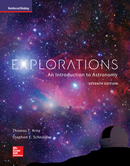1 6 times fainter than an identical Cepheid (in the Milky Way) 1000 parsecs away. How far away is the nearby galaxy?2 3 4 5 6 -5 arc seconds, which is about the best resolution currently possible with the radio astronomy technique of very long baseline interferometry.7 8 9 15 M.. If the cluster contains 100 galaxies, each with typical masses of 1011 M., and 10 times as much mass in hot X-ray gas as in galaxies, how much dark matter is contained in the cluster? What percentage of the total mass is this?10





